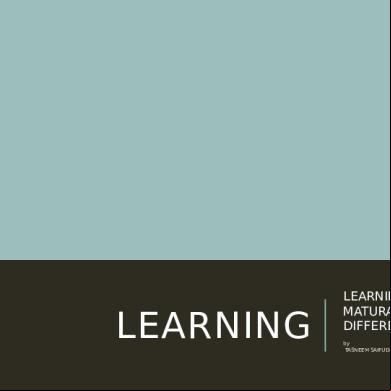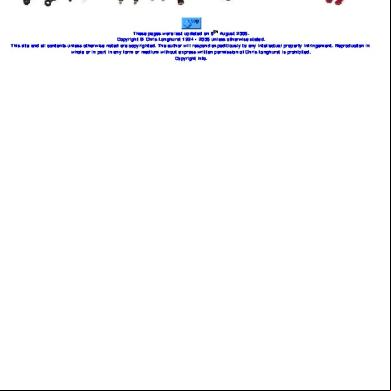Learning And Maturation 4k54c
This document was ed by and they confirmed that they have the permission to share it. If you are author or own the copyright of this book, please report to us by using this report form. Report 3b7i
Overview 3e4r5l
& View Learning And Maturation as PDF for free.
More details w3441
- Words: 656
- Pages: 19
LEARNING
LEARNING AND MATURATION AT DIFFERENT LEVELS OF AGE by TASNEEM SAIFUDDIN
DEFINITION OF LEARNING To learn loosely means to have discovered something new Learning is defined as “any relatively permanent change in behaviour that occurs as a result of practice and experience” This definition has three important elements. a. Learning is a change in behaviour—better or worse. b. b. It is a change that takes place through practice or experience, but changes due to growth or maturation are not learning. c. c. This change in behaviour must be relatively permanent, and it must last a fairly long time.
LEARNING CONNOTES CHANGES It is complex . At one end individual is learning new skills and at other improving the already existing skills Building a store of information or knowledge Developing interests , attitudes and ways of thinking
DIRECTION OF LEARNING it may be vertical ; addition of the knowledge that is already existing It may be horizontal; gaining mastery of knowledge
PRINCIPLES OF LEARNING Learning must follow sequences. Learning can proceed at varying rates. Learning result from an interaction of maturation and experience. Early experiences have profound effects on learning. Learning is always cooperative For an effective learning readiness of a learner is necessary Repetitive trials and drill are necessary for learning
PRINCIPLES OF LEARNING Learning is strengthened when accompanied by a pleasant or satisfying feeling , and learning is weakened when associated with an unpleasant feeling. The more intense the material taught, the more likely it will be retained Things freely learned are best learned. Conversely, when a student is coerced, the more difficult is for him to learn, assimilate and implement what is learned. Things learned first create a strong impression in the mind that is difficult to erase The principle of recency states that things most recently learned are best ed.
MATURATION AND LEARNING Maturation and learning go hand in hand in the process of human development, growth of the structures of the body makes it possible to perform several activities and these activities make learning possible. Most of the abilities of the adult are, "therefore, dependent on both maturation and learning. There are some abilities which do not depend on learning. The first stage of development must consist wholly of maturation. An organ must have developed to a certain point before it can begin to function. For example, the heart could not start pumping blood into the arteries until it had developed for enough to be a workable pump.
MATURATION AND LEARNING Once maturation has provided an organ that can work or function, it has to be strengthened by exercise. . Woodworth and Marquis have mentioned, "All knowledge and skill all habits good or bad, all acquaintance with people and things, all attitudes built up in your dealing with people and things, have been learned".
MATURATION AND LEARNING OF SKILLS AT DIFFERENT STAGES
DIFFERENT STAGES OF MATURATION AND LEARNING
FOUR STAGES OF LEARNING These four stages of learning, also known as the four stages of competence where first uncovered by Noel Burch of Gordon Training International, although Abraham Maslow is often erroneously credited.
FOUR STAGES OF LEARNING UNCONSCIOUS INCOMPETENCE : “ I DON’T KNOW THAT I DON’T KNOW THIS” CONSCIOUS INCOMPETENCE : “I KNOW THAT I DON’T KNOW HOW TO DO THIS” UNCONSIOUS COMPETENCE: “I KNOW THAT I KNOW HOW TO DO THIS” CONSCIOUS COMPETENCE: “WHAT YOU SAY I DID SOMETHING WELL !!’’
DIFFERENT STAGES OF LEARNING STAGE 1: EMERGENT THE BURNING QUESTION IS “WHAT I AM LEARNING?” APPROACH : TEACHER CENTERED STAGE 2 : BEGINNER THE BURNING QUESTION IS “CAN I GET IT RIGHT?” APPROACH : IVE AND INSTRUCTIVE
DIFFERENT STAGES OF LEARNING STAGE 3: DEVELOPING METHOD: INSTUCTOR AND LEARNER SHARE IN DECISION MAKING . APPROACH : LEARNER CENTERED STAGE 4: MATURE METHOD INSTRUCTOR ACT AS CONSULTANT OR ADVISOR ROLE OF INSTRUCTOR IS ONLY TO GUIDE.. FREEDOM IS REQUIRES
MATURATION AND LEARNING AT DIFFERENT STAGES
LEARNING AND MATURATION AT DIFFERENT LEVELS OF AGE by TASNEEM SAIFUDDIN
DEFINITION OF LEARNING To learn loosely means to have discovered something new Learning is defined as “any relatively permanent change in behaviour that occurs as a result of practice and experience” This definition has three important elements. a. Learning is a change in behaviour—better or worse. b. b. It is a change that takes place through practice or experience, but changes due to growth or maturation are not learning. c. c. This change in behaviour must be relatively permanent, and it must last a fairly long time.
LEARNING CONNOTES CHANGES It is complex . At one end individual is learning new skills and at other improving the already existing skills Building a store of information or knowledge Developing interests , attitudes and ways of thinking
DIRECTION OF LEARNING it may be vertical ; addition of the knowledge that is already existing It may be horizontal; gaining mastery of knowledge
PRINCIPLES OF LEARNING Learning must follow sequences. Learning can proceed at varying rates. Learning result from an interaction of maturation and experience. Early experiences have profound effects on learning. Learning is always cooperative For an effective learning readiness of a learner is necessary Repetitive trials and drill are necessary for learning
PRINCIPLES OF LEARNING Learning is strengthened when accompanied by a pleasant or satisfying feeling , and learning is weakened when associated with an unpleasant feeling. The more intense the material taught, the more likely it will be retained Things freely learned are best learned. Conversely, when a student is coerced, the more difficult is for him to learn, assimilate and implement what is learned. Things learned first create a strong impression in the mind that is difficult to erase The principle of recency states that things most recently learned are best ed.
MATURATION AND LEARNING Maturation and learning go hand in hand in the process of human development, growth of the structures of the body makes it possible to perform several activities and these activities make learning possible. Most of the abilities of the adult are, "therefore, dependent on both maturation and learning. There are some abilities which do not depend on learning. The first stage of development must consist wholly of maturation. An organ must have developed to a certain point before it can begin to function. For example, the heart could not start pumping blood into the arteries until it had developed for enough to be a workable pump.
MATURATION AND LEARNING Once maturation has provided an organ that can work or function, it has to be strengthened by exercise. . Woodworth and Marquis have mentioned, "All knowledge and skill all habits good or bad, all acquaintance with people and things, all attitudes built up in your dealing with people and things, have been learned".
MATURATION AND LEARNING OF SKILLS AT DIFFERENT STAGES
DIFFERENT STAGES OF MATURATION AND LEARNING
FOUR STAGES OF LEARNING These four stages of learning, also known as the four stages of competence where first uncovered by Noel Burch of Gordon Training International, although Abraham Maslow is often erroneously credited.
FOUR STAGES OF LEARNING UNCONSCIOUS INCOMPETENCE : “ I DON’T KNOW THAT I DON’T KNOW THIS” CONSCIOUS INCOMPETENCE : “I KNOW THAT I DON’T KNOW HOW TO DO THIS” UNCONSIOUS COMPETENCE: “I KNOW THAT I KNOW HOW TO DO THIS” CONSCIOUS COMPETENCE: “WHAT YOU SAY I DID SOMETHING WELL !!’’
DIFFERENT STAGES OF LEARNING STAGE 1: EMERGENT THE BURNING QUESTION IS “WHAT I AM LEARNING?” APPROACH : TEACHER CENTERED STAGE 2 : BEGINNER THE BURNING QUESTION IS “CAN I GET IT RIGHT?” APPROACH : IVE AND INSTRUCTIVE
DIFFERENT STAGES OF LEARNING STAGE 3: DEVELOPING METHOD: INSTUCTOR AND LEARNER SHARE IN DECISION MAKING . APPROACH : LEARNER CENTERED STAGE 4: MATURE METHOD INSTRUCTOR ACT AS CONSULTANT OR ADVISOR ROLE OF INSTRUCTOR IS ONLY TO GUIDE.. FREEDOM IS REQUIRES
MATURATION AND LEARNING AT DIFFERENT STAGES










